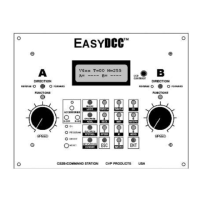58
Introduction To Multi-Unit Consisting
A consist is a group of locomotives that operate together as if they were a single unit. This section
describes the various ways that consists can be created with the EasyDCC System.
A Few Definitions Are Needed First
There are many different names used to refer to a group of locomotives acting as a single unit or
in other words, a multi-unit consist or simply consist for short. The EasyDCC System supports
both standard and advanced consists. Each type has pros and cons and the following section will
help you choose the most appropriate type.
There is one other type of consist called a “Basic Consist.” However, that refers to a consist
created by simply having all the locomotives programmed to the same address.
Advanced Consist
Advanced Consists (ADV) are the recommended method for creating multi-unit locomotive
consists. It has the advantage of providing much more flexibility for how function commands are
interpreted by each locomotive in the consist, an important consideration when using sound
decoders. For example, the lead unit might be the only unit that sounds the horn but all units will
have their dynamic brakes turned on when that function is enabled.
An advanced Consist is created when two or more locomotives operate together by
programming each locomotive decoder in the consist to a shared "secondary" or “advanced
consist” address. To do this, locomotives must be powered up to receive the reprogramming
commands and reprogramming occurs on the main line. You do not use the programming track to
set up advanced consists.
The Advanced Consist address range is 1 to 127 as defined by the NMRA-DCC standards.
However, EasyDCC limits the range to 1 to 99. As a result, a locomotive with an address of 10
will also respond to Advanced Consist address of 10. Therefore, consider reserving this block of
numbers for use only by advanced consists.
The benefit of this type of consist is that up to 8 locomotives can be in the consist yet the
Command Station only sends out a single command to the advanced consist address. Thus, the
Advanced Consists provide the fastest possible system performance for a group of locomotives.
Locomotives placed into an advanced consist will remain in the consist even if moved to another
layout. The locomotives will all operate as a consist the moment the throttle is set to the advanced
consist address.
Standard Consists
A Standard Consist (STD) is created when two or more locomotives are connected together and
operated as a single unit but are allowed to use their own individual locomotive addresses. When
the standard consist is built, a table is created inside the command station. The lead locomotive
address becomes the consist address. The table is used to tell the Command Station all of the
other addresses tied to the lead locomotive so that it will sequentially send out commands when a
throttle command is received. The locomotives still use their original speed step setting.
The consist address can be any number from 1 to 9999. Throttle commands are sent to the lead
locomotive plus all the other locomotives in the consist table. The locomotive decoders are not
changed in any way. A standard consist can be built without having the locomotives on the
layout.
While this sounds easy, the downside is that a single consist having 8 locomotives will cause the
Command Station to take up to 8 times as much time to send out throttle commands. As a result,
overall system performance slows down and sound functions like horn activation may
experience a noticeable delay. As more and more standard consists are used, the response time
will slow to a crawl. We have tested 31 throttles simultaneously controlling 31 consists with each
consist having 8 locomotives - a total of 248 active locomotives. The response time was simply
unusable. For the highest performance system, always use either advanced or basic consists.

